“The journey, the path, the legacy, following dreamz, going home.” -Ibn
The Juju Spirit radiates throughout the works of Detroit artist Aaron Ibn Pori Pitts. Hearts, arrows, crosses and hoodoo symbols from West Africa; Yoruba, Bantu, Mali and Dogon culture, clash and frame layered, over-painted portraits of Ornette Coleman, James Brown, Malcolm X, Faruq Z. Bey, Rosa Parks and others.
Revolution, community, and the beat of life are Ibn’s subjects. Smashed cans, food wrappers, urban waste and cultural leftovers overlap side-by-side on large irregular shaped support material made from scraps of cardboard and sheets of found vinyl. Covered in a thick polyurethane gloss, the collages glow with historic and spiritual qualities—bathed in memory, thinking quilts of our time. They move and pulse in rhythmic African dance, ablaze with color, depth, and energy.
“Urban folk culture iz the continuation of the past/future w/improvisation used az the key life-force to survival.” -Ibn
Since the mid 1960s, 70-year-old Ibn has produced art under many names and collectives including The Black Graphics International, Ogun Urban Monumentz, African Burial Groundz, Kcalb Gniw Spirit, Ogun Ritual Altars, Ogun Monument Warriorz, Incarnationz, and Tributes to the African Ethoz. His works celebrate Juneteenth, Nelson Mandala, Mumia Abu Jamal, African pride blues, and jazz. They speak on behalf of political prisoners, the repressed, and unrepresented.
Ibn has toured the country reciting poetry with jazz great Henry Grimes and performed in numerous one-off free jazz band ensembles known simply as “Band Unit #10.” His art has been displayed on city streets as well as galleries in Detroit, New York, Los Angeles, Toronto, Senegal, Birkina Faso, Abidjan/Ivory Coast, Kingston Jamaica, and Brazil. Ibn is a free citizen of the Pan-African, Sun Ra Omniverse, and an Afro-futurist practicing art on the outer edges of Western tradition—faraway from what Ibn has termed the thick mire of fetish materialism.
“For the essence of r own soulz, for freedom’z call, for this struggle for an egalitarian society, for thiz iz the call…. the meaning of it all.” -Ibn
Ibn’s portrait-collages are heroic graffiti-flags, memorial billboards and ‘tombstones’ for justice, alive with an African/urban aesthetic. His ancestor series is referred to as “burial groundz” and “urban monumentz”—time machine artworks that are the descendants and extensions of Jean-Michel Basquiat, Jacob Lawrence, and Romare Bearden. These politicized urban assemblages are opposed to mass conformity and packaged pop. Ibn’s raw artworks are saturated with mystical references and elements of erasure, gestural markings, and deep rubbing reliefs. They bring to mind the surrealist frottage of Max Ernst, the tight pop collages of Robert Rauschenberg, and the lyrical madness of Willem de Kooning.
Ibn developed private subterranean codes and markings, related to hobo writing, railroad graffiti, astrological charts, and African hieroglyph patterns. These complex marks, mixed with multiple layered and improvised blocks of color, create sonic fields of free-jazz dimensions. Ibn has made musical improvisation come alive in collage with a multitude of styles, messages, and fresh poetic experiments linked to language.
Ibn is a revered African-American elder. His quietly intense public presence in Detroit was the litmus test when anything of cultural/spiritual importance occurred. He methodically documented countless concerts, lectures, and events, his video camera a constant companion. He kept alive an enthusiasm for life and ritual, a thirst for knowledge and the pure expression of joy, freedom, and innocence. Ibn lived a reality deeper than reality.
“Taking back the righteouz voice of r elderz and the voice of the children shall be heard, taking back the meaning of the black/bluez, giving life to the spirit.” -Ibn
Vision in a Cornfield / Ogun Urban Monumentz
One night in the late ’90s while assisting on Cameron Jamie’s Spookhouse film, Mike Kelley and I heard a loud rumble coming from a cornfield near Fowlerville, Michigan. We followed the sound until we came across a solitary low-rider complete with fuzzy dice hanging from the rear-view mirror. There were no occupants in the car yet the interior was filled with smoke. The auto was sitting among the cornstalks, glowing in deep purple from lights underneath the running boards and throbbing with a loud bottom heavy noise rumbling from the trunk. We saw the car and sound as ‘alien’ installation art and decided to recreate this in our own way.
We discussed animating automobiles, giving them exaggerated robotic motion, humping sexed-up cars, life-sized autos as toys, “hot-wheels” filtering damaged DAM music. We thought of sharing our sample library with other artists (especially techno musicians) and having the mutated ‘transformer’ autos converse and dance with the new mixes. The dancing car sample project was always on our minds, but the bulk of our samples were stored on floppy discs and other vanishing formats that needed preservation.
I recalled Ibn’s automobile project of the ’80s and ’90s, Afro-futurist shrines dedicated to ancestors he called Urban Monumentz. These were West African Orisha altars. Sites of transformation and musical ritual, intensely designed and spiritually charged. Ibn connected African religion and vodou to the streets, reimagining and framing one of our most valued consumer objects with the warrior divinity Ogun.
In the 80s and 90s, scrap metal was cheap and Detroit was littered with countless rusted-out automobiles. Ibn neutralized these post-consumer rejects and signs of blight into objects of rare beauty and poetry through ceremonial purification. Through the spirit of Ogun, the African god of iron and metal (also the god of thunder, war, revolution, and slave revolts), Ibn and his collective, delivered the dead metallic hulks back into the community as something beautiful from the earth. The Kclab Gniw Spirit group acted as shamanic warriors, consecrating their altars in the name of departed souls, revolutionary leaders, jazz musicians, and artists.
Kelley agreed this would make an interesting collaboration between our collectives and we often discussed it. I spoke with Ibn in 2002 about creating a joint installation, and at one meeting Ibn shared photographs and a catalog of his automobile shrines. We wanted to make it happen, yet the complexity of the project and Kelley’s insanely busy schedule made it impossible at the time.
Ibn suffered a massive paralyzing stroke while delivering a eulogy at a friend’s funeral in 2008. The stroke left him with limited mobility and difficult verbal skills. He now lives in a nursing home, bound to a wheel chair. Since Kelley’s death in January of 2012, the project looked even more impossible to complete.
While discussing a new MOCAD journal project with Rebecca Mazzei (a box project with roots in Afro-futurism), I mentioned the installation and cornfield vision. Mazzei believed in the project and thought we could make it happen and ready by the fall. We met with artist M. Saffell Gardner, a friend and member of the Kcalb Gniw Spirit collective, who agreed to manage the installation on behalf of Ibn and act as co-curator for the project.
Apetechnology, a Detroit collective of metal hackers formed out of Mark Pauline’s Survival Research Laboratory, was a logical source to transform the cars into motion. I noticed the group several years ago at the Maker’s Faire at Greenfield Village and thought a collaboration would be inevitable. We met at their aptly named “Destroy Compound.” They gave us a tour of their factory and demonstrated their robotic hacking skills. The group agreed to help animate and wire-up the automobiles for sound, a key part of the project.
Apetechnology used invisible electronic sensors to trigger a variety of noise events and movements for the autos. A total of four cars were purchased by MOCAD, hacked up, and made interactive by the audience who were producing sounds and movement just by walking near them. The doors shook, the trunks and engine hoods opened and closed by forced air hydraulics. The autos created an other-worldly post-industrial dance ritual and musical conversation.
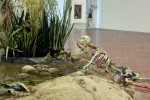 A central “Swamp Feature” was added to the installation. The swamp was inspired by another Destroy All Monsters project called Swamp Gas modeled after the Dexter UFO swamp which DAM members visited in 1998. Swamp Gas was a film, poetry, zine, and CD recording project based on the 1966 UFO sittings in Dexter, Michigan. An added element to the MOCAD swamp was a full scale painted skeleton watching its reflection in the swamp water. A film montage of Hollywood sci-fi disasters and apocalyptic film clips was projected into the swamp so the skeleton appeared to be either looking at the film or its own reflection.
A central “Swamp Feature” was added to the installation. The swamp was inspired by another Destroy All Monsters project called Swamp Gas modeled after the Dexter UFO swamp which DAM members visited in 1998. Swamp Gas was a film, poetry, zine, and CD recording project based on the 1966 UFO sittings in Dexter, Michigan. An added element to the MOCAD swamp was a full scale painted skeleton watching its reflection in the swamp water. A film montage of Hollywood sci-fi disasters and apocalyptic film clips was projected into the swamp so the skeleton appeared to be either looking at the film or its own reflection.
Hanging beside the cars were floating costumes or uniforms from an alien race. The space creature costumes were designed by Jennifer Pryce and Levon Millross. They were for the most part humanoid outfits hanging in space from wires. They made an eerie accompaniment to the UFO setting.
Samples from Destroy All Monsters were saved and digitized thanks to Scott Benzel and the Mike Kelley Foundation for the Arts. Due to time and legal limitations, the samples were unable to be distributed to other sound artists as originally planned. Instead, hundreds of samples were layered into “song groups” that played in random sequences through the cars, creating a call-and-response concert. Samples were also mixed with “Swamp Gas” poetry read by Mike Kelley. Sound was further manipulated by random pitch changes through a computer program developed by Leith Campbell at Apetechnology. Sounds bounced from car to car creating a surround sound effect that was also triggered by electronic sensor.
In the spring, Saffell and I met with Ibn and his brother Nehemiah at the nursing home to discuss the project and show him sketches of the proposed layout. Ibn’s speech was difficult, but he was positive with the idea and said “not to worry about it.” Saffell met with artist musician Lester Lashley, another Kcalb Gniw Spirit/Ogun member based in Chicago (who is also a founding member of the AACM). Lashley agreed to help with the Monumentz construction. A group of large painting/collages by Ibn were rescued by Saffell and the staff of MOCAD, and were also displayed, courtesy of Ibn and his wife Gloria.
The combined efforts of several collectives were gathered to produce this epic multi-level display, and the museum was supportive. It seemed fitting to be happening in Detroit during the departure year of both Faruq Z. Bey and Mike Kelley. This slow evolving project came together organically as if directed by psychic or ancestral forces. Opening night was magic. Ibn was present in his wheelchair, painting details on the cars as a group of African drummers, friends, and dancers spontaneously gathered and began to give out their praise song. It was a vodun moment for MOCAD, an ex-car dealership now in the embrace of supernatural high energy spirits.
An Afro-futurist themed journal titled Box #1 was assembled in time for the opening. Box #1 is a loose assemblage of books, prints, photos, posters, stickers, buttons, and recordings in an edition of 200 copies. Box #1 contains the LP Spirit Songz by Ibn with half a side by Sun Ra from a live residency in Detroit in 1980. Some of the artists featured in Box #1 are Leni Sinclair, Gary Grimshaw, Saffell, Ibn, Gilda Snowden, Amiri Baraka, Jim Shaw, Destroy All Monsters, RAMMELLZEE, Cameron Jamie, and Pedro Bell. A complete inventory of Box #1 is available here.
Vision in a Cornfield opened at MOCAD on Sept 7 through Dec 30, 2012. It was an honor to help bring the great poet/activist Amiri Baraka to view the installation and deliver a lecture at the Charles Wright Museum of African American History. Rest in Peace Amiri.
“We keep on keepin’ on… refusing to quit/ refusing to die young, that’z the trick resonating from thiz journey/ the vivid memoriez of their pathz/ the ancestorz legacy speaking inside ur being of their endurance az they followed dreamz that shaped r collective singular earring dangling from the next generations ear l o b e z.” -Ibn
All quotes from The Path by Aaron Ibn Pori Pitts, Black Graphics International, Detroit/Michigan/SNA. All photographs of Ibn’s artwork (shown in detail) were taken at MOCAD on 6/11/2012 by Cary Loren. Photo of Ibn courtesy of Saffell Gardner. Installation photos by Corrine Vermeulen.

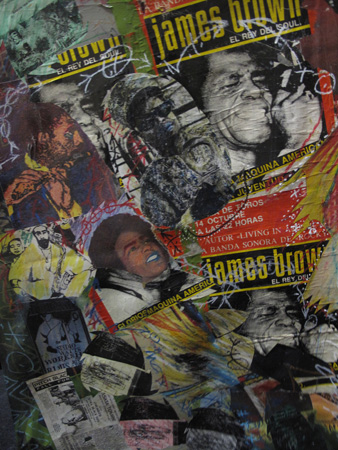


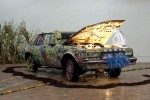
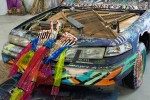
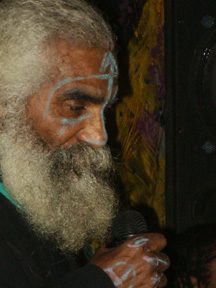
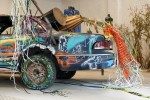
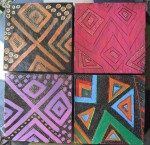
Hi Aaron:
Been too many years! Now living in Los Angeles (last 7 years).
Hope you and the family are well. I am trying to reach Gloria. I will be in Detroit next week. Please respond to this email. Thanks.
Joyce
sjkhinc@yahoo.com
Joyce
Ibn–I will always remember those days when you one of my writers at the Metro Times. Even then you were like that commercial with Bruce Lee that cites “obey the principles but don’t be contained by them.” Not only have you always thought outside the box, you have fought inside it and thereby given us a view from both sides. Like Robeson, keep on fightin’
Ibn–I will always remember those days when you were one of my writers at the Metro Times. Even then you were like that commercial with Bruce Lee that cites “obey the principles but don’t be contained by them.” Not only have you always thought outside the box, you have fought inside it and thereby given us a view from both sides. Like Robeson, keep on fightin’
For some reason Arron was on my mind today. I therefore did an internet search and found all this fascinating information about his life and work.
Aaron and first met in Elementary school, and became fast and close friends. We often visited each others homes, but sort drifted apart in our high school years. I, for all practical purposes, left Detroit post high school and only came back for short visits with family. Aaron was always blessed with artistic skills and its wonderful that he was lead be a revolutionary, keeper of the culture, genius. Having traveled throughout the African continent for over 35 years I sincerely wish that Arron and could have collaborated or as least shared our life experiences.
So sorry to learn of his health challenges, but knowing his legency will live long beyond our tenure on this earth.